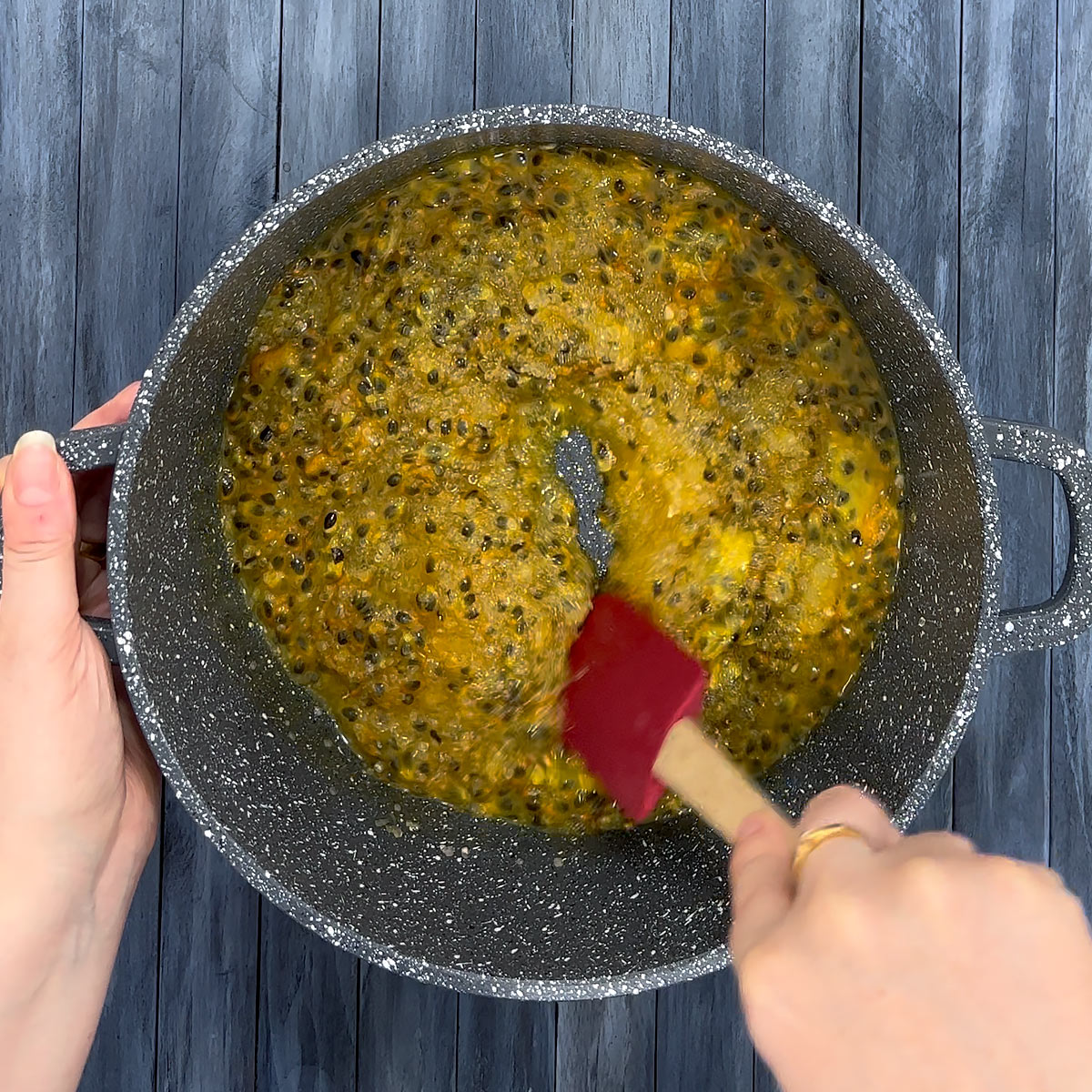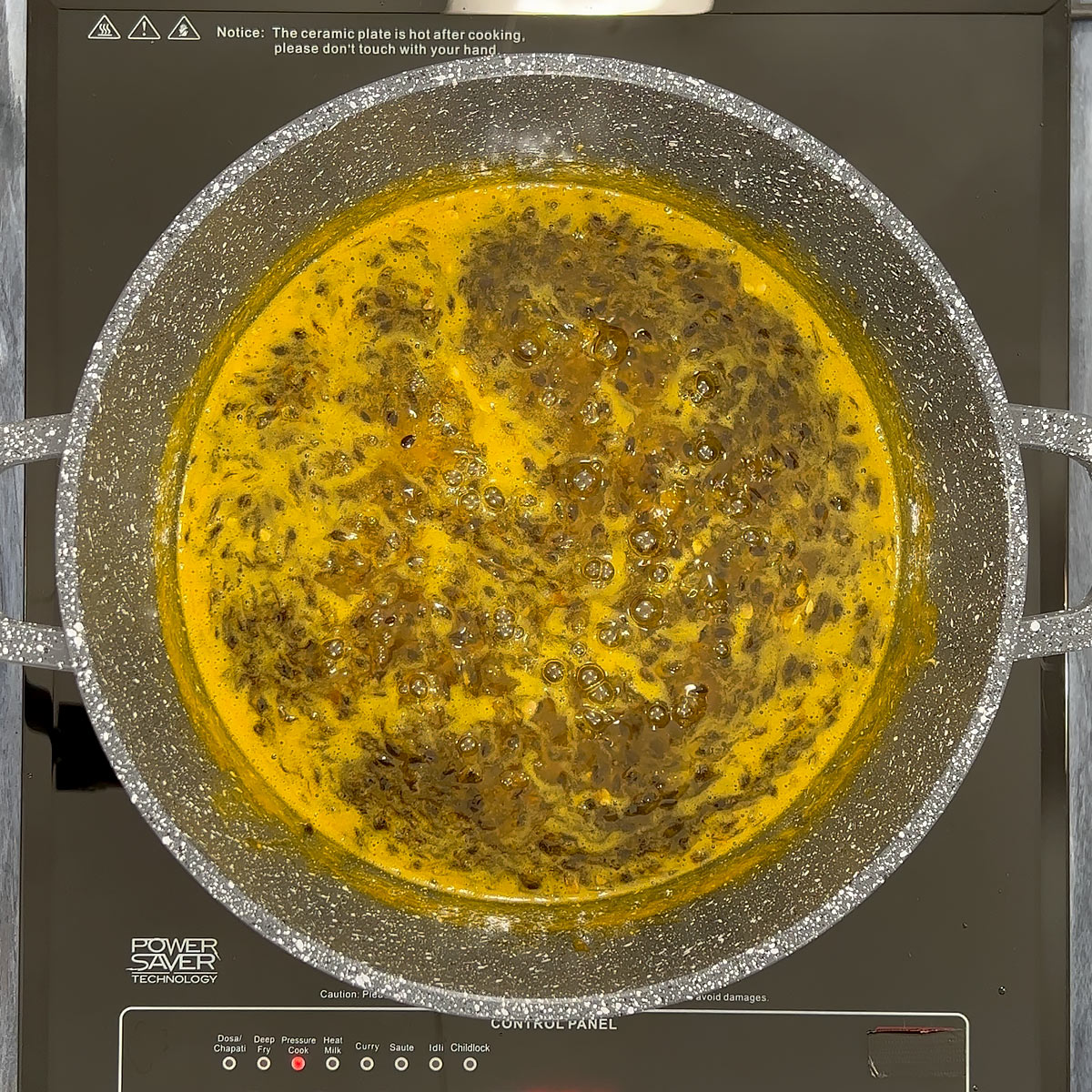
Passion Fruits are fantastic tropical fruits that deserve to be turned into a sweet and tangy jam.
Here is how I prepare my passion fruit jam at home with our homegrown passion fruits.

TL;DR
Passion fruits are tart, pulpy, super fruity, fragrant, tropical fruits. It's also known as Maracuja in some languages.
We grow them in our garden in Goa, we have 2 varieties, the yellow and purple ones. That explains why I have been posting several passion fruit recipes over the years.
They taste fantastic, and the harvest is bountiful and almost all-year-round, but I usually get about 1–2 fruits per day when they drop from the vine. So, I end up collecting the pulp in a container to freeze to make a small batch jam.

Then I either use the pulp to make a passion fruit jam or anything else where I need the crunchy seeds, or I will strain it to prepare a pure passion fruit puree.
You can do the same thing, if you have passion fruits growing, or whenever you see the fruits on sale in your grocery store.
I have seen mostly purple ones in the Northern Hemisphere and because the locals don't know what to make of them, they tend to be sold discounted as a batch (and that's when you should make this small batch passion fruit jam).
Ingredient Notes
This recipe consists of 2 ingredients only.
- Passion Fruits — Fresh fruits or passion fruit pulp. It can be frozen too. Either yellow or purple or any other passion fruit variety.
- Sugar — Regular granulated sugar. You don't need special jam sugar.

Process Overview
Step 1
Cut your passion fruits in half. Spoon out the passion fruit pulp and collect it in a bowl until you have the required quantity.


Step 2
Pour the passion fruit pulp with the seeds into a pan with the sugar. Mix it all well and take to the heat.


Step 3
Bring to a rolling boil, then cook down until it looks translucent and set. With a smaller quantity over a medium-low heat setting, this can take about 20 minutes.



Step 4
Test if the jam is set with a candy thermometer or by dropping hot jam on an ice-cold plate so that the jam cools down instantly to reveal its true consistency. If it's not running on the plate, it's set, and you are done cooking, if it's running, cook it down further and repeat the testing process a few minutes later.
The setting temperature is 105 Celsius/220 Fahrenheit.

Step 5
Pour hot jam into clean jars when set. We drop some food grade liquor into the lids to kill off remaining bacteria (optional). Seal the jar tight and turn upside down to create a vacuum. Turn back up when the jar isn't all too hot anymore.
Enjoy the jam.



📖 Recipe

Small Batch Passion Fruit Jam Recipe
Instructions
- Cut open your passion fruits and scoop out the jelly-like passion fruit pulp with seeds. Collect the pulp in a bowl. Measure in cups or weight.2 Cup Passion Fruit Pulp
- Pour passion fruit pulp into a pan, I just used a small pan for a smaller batch. Pour sugar to the passion fruit pulp and mix it all up.1⅔ Cup Sugar
- Take the passion fruit sugar mix to the fire and bring to a rolling boil over a medium-high heat setting.
- Reduce the heat a bit and allow simmering so that the jam can reduce and then later set. This can take about 20 minutes if you work with the base recipe batch size.
- The jam is set when it appears relatively translucent and thicker. Test the jam with a candy thermometer, the setting temperature is 105 Celsius/220 Fahrenheit, or test with an ice-cold plate. For the ice-cold plate, drop a small quantity of jam on the cold plate and turn around the plate to see if it's running or not. The cold plate will cool down the hot jam instantly, revealing its true consistency (hot jam always appears liquid) and when it doesn't run it's set. If it's running, reduce it a little further a repeat the setting test until it's set.
- Pour the hot jam into clean sterilized jars (I sterilize them in the dishwasher with an empty cycle) almost up to the rim. Optionally, you can drop some liquor into the jar lid to kill bacteria. Clean the jar with the wettex sponge, if you made a mess. Close the jar tight with the lid and quickly turn the jar upside down (careful, it's hot) to create a vacuum. Leave the jar like that for 1–2 hours or until the jar has cooled down a bit, and then turn it back up.
- Store in a dry place away from direct sunlight on a visible pantry shelf. Keep in the fridge once it has been opened.
Notes
Equipment
- 3.5" Paring Knife
- Kitchen Scale or Cup
- Pan
- Candy Thermometer to check setting of the jam. (optional)
- A small Plate left in the freezer 2nd option to test jam setting point
- Silicone Spatula To help you scrape out all the jam from the pan.
- Wettex Absorbent Sponge To clean jars if you made a mess.
Nutrition
Tips
- Test the setting by dropping hot jam onto a cold plate. Before you begin making your jam, place a small quarter plate in the freezer. If the jam is not running on the plate, it is ready, and you can pour it in your jars.
- As an alternative, a candy thermometer is the safest way to check your jam setting. The setting temperature is 105 Celsius/220 Fahrenheit.
- Use only clean jars. Your jars and lids should be sterilized. This is important if you want your French jam to last longer. Jam jars and lids can be sterilized by boiling them in hot water, heating them on a rack in the oven, or washing them in a high heat setting in your dishwasher.
- If you carefully follow this recipe, work in a clean space, and keep your jam in a cool, dry place out of direct sunlight, it will last at least 10–12 months.
- If you alter the amounts of ingredients, the shelf life will be significantly shortened. Sugar is a main ingredient in preserving your jam and helps in preserving it.
- If you skip adding sugar to your jam (passion fruit is super tart, so I don't recommend it), eat your jam within days.
- Never double dip as this reduces the shelf life of your jam.
- Once you have unsealed a jar, store in the fridge.


Serving
We generally enjoy jams slathered over our breakfast rolls in the morning. That's a typical European breakfast.
Nonetheless, a jam like this passion fruit jam can be used to layer cakes (aka nappage for glazing), to fill pastries (doughnuts), or as a cookie filling (think Linzer cookies).
At home, we add jam to our plain unsweetened yogurts, e.g., French yogurt, to enjoy as an evening TV-time dessert.
You are free to experiment! Flavor your breakfast oatmeal, Tibetan barley tsampa, breakfast semolina, or your milk rice porridge with this passion fruit jam.

Storing
Keep your unopened jars of passion fruit jam on a pantry shelf out of the direct sunlight and moisture.
If you follow the French jam-making method without a water bath, they will keep for 10 to 12 months.
You can do the FDA approved canning recommendations, by water bath canning your jam after you are done filling them with the passion fruit jam. This can provide an additional layer of protection to your jam and extend its shelf life.
Keep the jars in an air-conditioned environment or in your refrigerator if you reside in a humid, hot environment.
After opening the jar, put it in the fridge at all times. Never double dip as this can cause mold growth and this habit is unhygienic.



Comments
No Comments